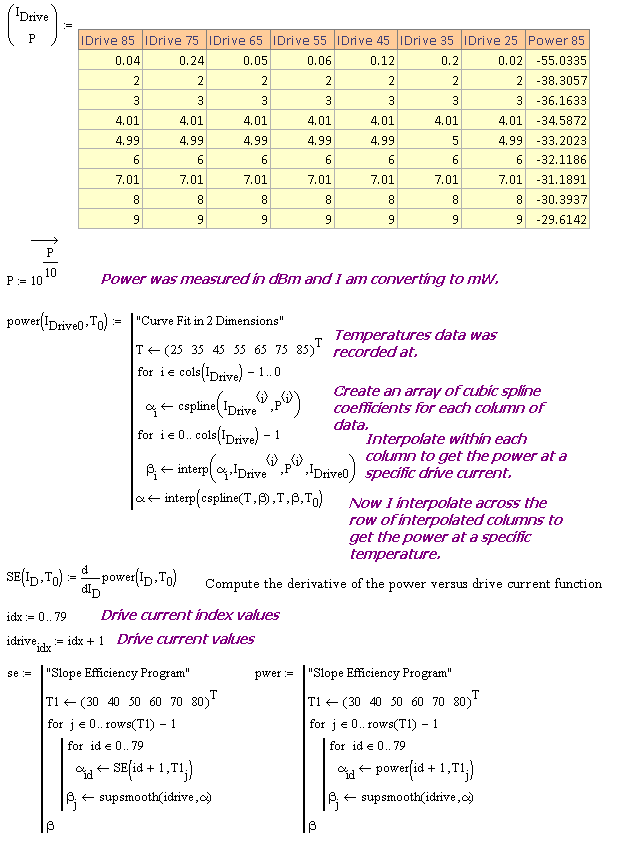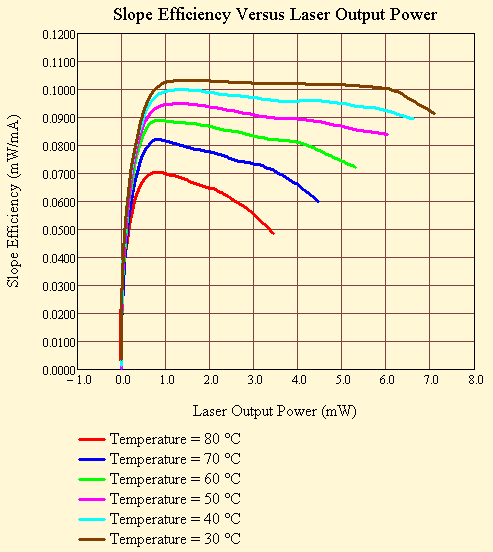Introduction
I have spent much of my summer dealing with issues related to the high temperature characteristics of lasers. These issues have stirred within me an interest in laser slope efficiency . Slope efficiency, also known as SE, is simply the slope of the laser's output power versus drive current curve. It varies from part-to-part and with temperature.
I am interested in how SE changes at temperatures above room temperature, which I will define here as 25 °C. I have drive current versus optical power and temperature data, and I need slope efficiency versus optical power at various temperature levels. This means more hammering of data into the form that I need for presentation.
This post will assume some knowledge of the electrical characteristics of a laser, which I covered in this post.
Background
If I had my choice, I would make SE a constant. Unfortunately, nature has not been that kind. As with most things electronic, things degrade rapidly with increasing temperature. In order to plot SE versus optical power at various temperatures, we need to precisely define what SE is. Equation 1 presents the formal definition.
| Eq. 1 |
where
- POutput is the laser output power, which is a function of drive current and temperature
- T is the ambient temperature that is varying over a range from 30 °C to 80 °C
- IDrive, the drive current into the laser.
Note that Equation 1 shows SE as a function of IDrive and temperature. However, I need to relate SE (the derivative of POutput) to POutput. All I need to do is to plot SE versus POutput by using IDrive as a parameter.
Analysis
My Data
Figure 1 shows a plot of the data I have. The data always comes to me in the form of an Excel worksheet, and it shows POutput versus IDrive at various temperatures. What I need is SE versus POutput at various temperatures.
Approach
Here is my approach for analyzing this data:
- I insert an Excel component into Mathcad, and I then insert the data into the Excel component.
- I perform a two-dimensional curve-fit using cubic splines to generate POutput(IDrive,T).
- I compute SE by taking a derivative of POutput with respect to IDrive.
- Compute POutput versus the same IDrive values that I used to compute SE.
- I now plot my SE versus POutput for the same values of IDrive at various temperatures.
Interpolation
Figure 2 shows a screenshot from Mathcad of my data and interpolation approach. I used a Mathcad program to actually process the data. I find the programs simple to develop and easy to use.
Slope Efficiency Versus Optical Power at Various Temperatures
Figure 3 shows the final result of my work. Note how SE degrades with temperature.
- Figure 3: Laser Tracking Error Versus Temperature.
Conclusion
I thought this was a good, practical example illustrating two-dimensional interpolation applied in an actual application. I often need to present data in a way that differs from how the data was originally gathered. Interpolation allows me to obtain the data I need with minimal effort.




Pingback: Using a D-Size Battery String for a UPS Energy Source | Math Encounters Blog
How can I theoretically calculate the slope efficiency of a fiber laser (either RE-doped or Raman)? Thanks.
how do i calculate this for a laser pointer?
You need access to the laser drive pins so that you can run the drive current over a range.
mark